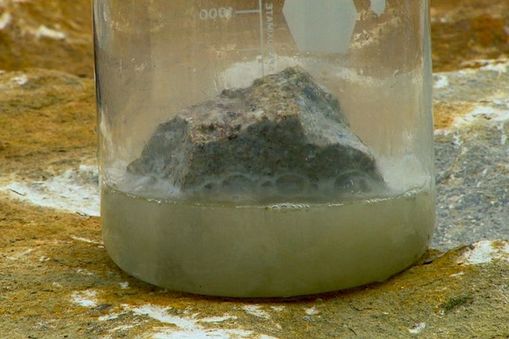The purpose of this experiment is to discover the reaction rate in which acid rain weathers marble statues, or in our case, marble chips.
Introduction
Marble is especially sensitive to the degrading by acidic chemicals, also to weathering. Acid rain is one of the top degradation agents for marble artifacts around the world. Acid rain contains carbonic acid, nitric acid, and sulphuric acid (CO2, NO2, and SO2). The chemical equation that is going to be followed throughout the experiment will be:
CaCO3(s) + 2HCl(aq) –> CaCl2(aq) + H2O(l) + CO2(g)
Multiple factors can impact on the rate of the reaction between the acidic factors and the marble particles. These are stated below;
- The particle size of the marble and the acid
- Concentration
- The temperature of the climate around the statue.
Questions and Hypotheses
|
Independent Variables |
Controlled Variables |
Dependant Variables |
|
|
|
Hypothesis
The higher the concentration of hydrochloric acid in the beaker, the faster the reaction will take place. This is because there will be more hydrochloric acid particles to collide with the marble chip particles. Therefore resulting in a quicker reaction. The lower the concentration, the weaker the reaction will be as there will be fewer particles, so there will be less chance of the marble reacting.
Apparatus
- Safety goggles
- Hair tied back
- Appropriate footwear
- All chairs tucked under benches
- Approval from the teacher before carrying out your experiment
- Supervision
Materials
- 4g of marble chips
- 24 ml of hydrochloric acid
- 30 ml of diluted water
- A spatula for the marble chips
- Scientific weighing scales
- 4x test tubes
- Stopwatch
- 1x 10ml measuring cylinder
Procedure

(The results that are collected will need to be recorded, a table will be necessary for this.)
- Set up test tube next to each other in visible site
- Numbered each test tube with #1, #2, #3, and #4 written on the tape.
- Plugged in scientific scales and weighed out 1g of marble chips for each test tube.
- Marble chips placed onto pieces of paper.
- Measured 5ml of hydrochloric acid in the 10ml measuring cylinders and placed into each beaker separately.
- Measured out 1ml of water in a 10ml measuring cylinder and placed into the test tube labeled #2.
- Measured out 2ml of diluted water in a 100ml measuring cylinder and placed into the test tube with label #3.
- Measured out 3ml of diluted water in a 100ml measuring cylinder, and placed into the test tube with label #4.
- Referred to the table that was drawn before starting the experiment.
- Prepared the stopwatch to record how long it took for the marble chips to dissolve.
- Used the pieces of paper to put the marble chips into the test tubes #1, #2, #3, #4
- Started the timer and recorded the time it took for the marble chips to dissolve.
Results Table
|
TEST TUBES |
TIME TAKEN |
OBSERVATION |
| Concentrated (test tube #1) | 22 minutes and 24 seconds | Hydrochloric acid went white and was fizzing; the test tube had gathered around 4 cm of condensation. |
| Diluted (1ml) (test tube #2) | 24 minutes and 18 seconds | Diluted hydrochloric acid (1ml) went white and was fizzing; the test tube had gathered around 6 cm of condensation. |
| Diluted (2ml) (test tube #3) | 25 minutes and 37 seconds | Diluted hydrochloric acid (2ml) went white and was fizzing; the test tube had gathered around 7 cm of condensation. |
| Diluted (3ml) (test tube #4) | 27 minutes and 9 seconds. | Diluted hydrochloric acid (3ml) went white and was fizzing; the test tube had gathered around 8 cm of condensation. |

thank you, this is really organised and useful
Thank you so much
great cheat sheet
good article 10/10 helped
thanks, helped me pass science, thank you
Thanks, helped me with my assignment
this really helped me with my ISA mock! thank-you!
Cheers!
Thanks…